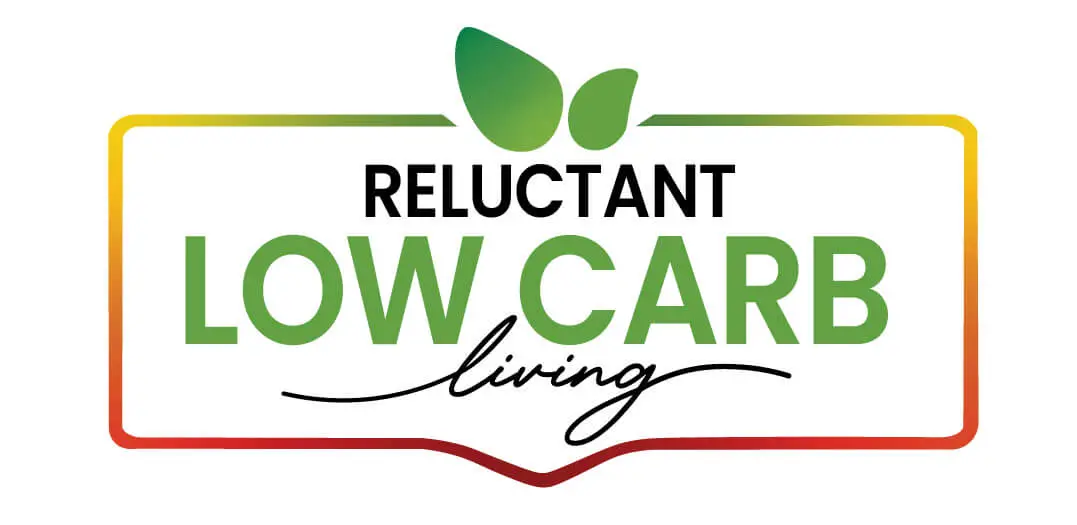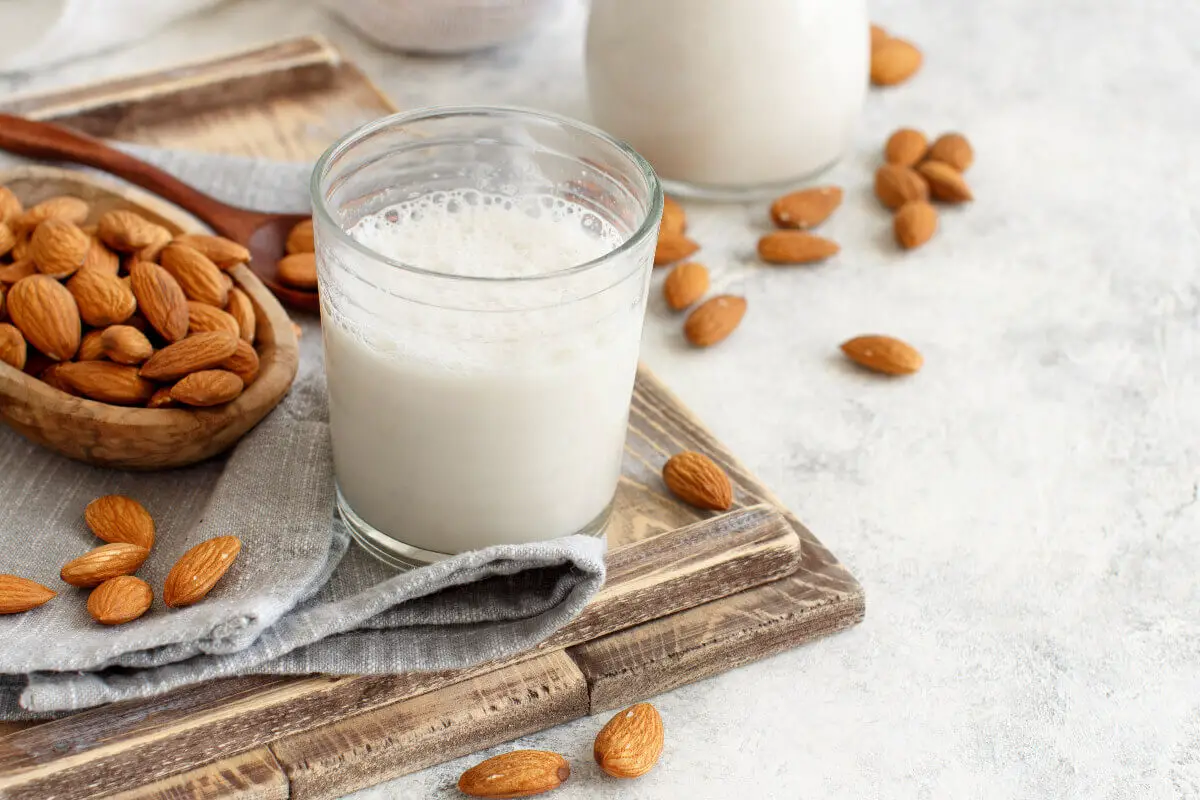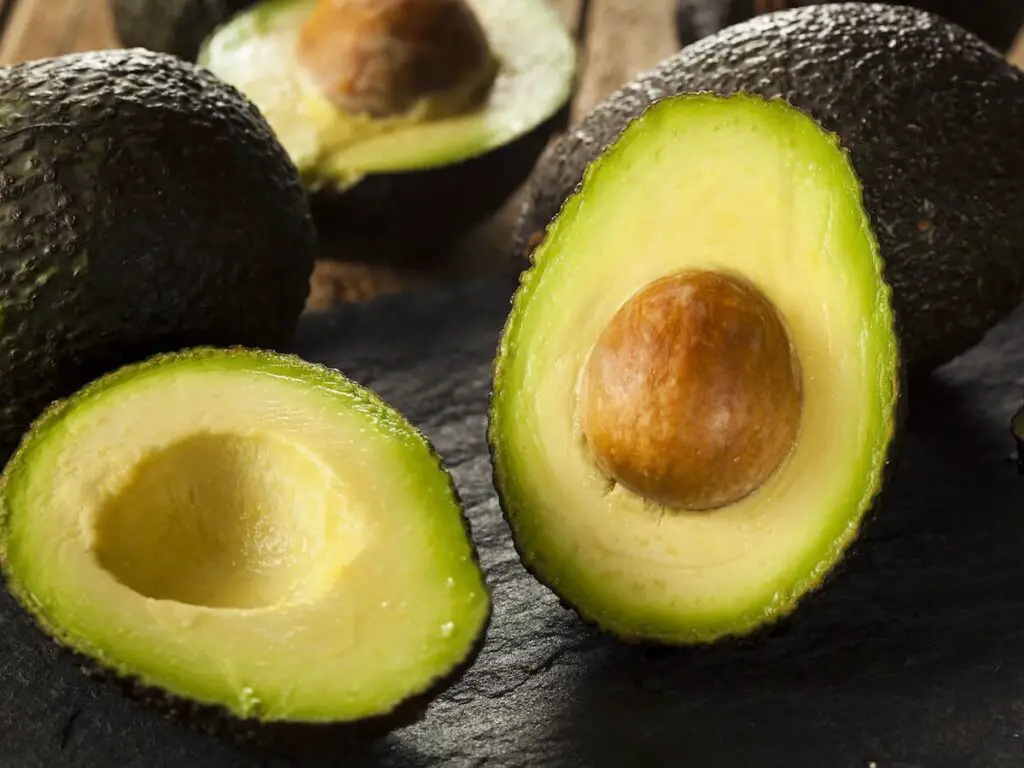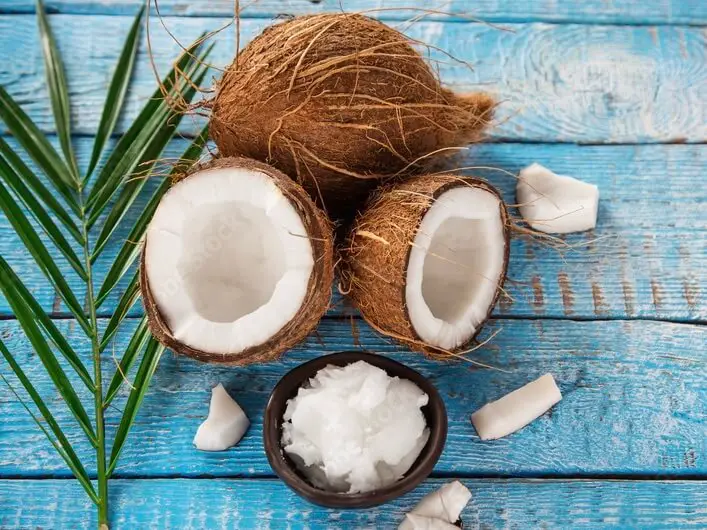As contemporary kitchens continue to evolve, the debate over traditional ingredients versus their modern alternatives is a hot topic on the culinary front. Among the myriad choices, almond milk is a prominent contender to classic cow’s milk.
In this exploration, we’ll dive into the intricate world of almond milk, comparing it to regular milk regarding nutrition, culinary prowess, lifestyle fit, and sustainable practices. Whether you’re a committed foodie, a nutrition enthusiast, or someone looking to shake up your grocery list, join us as we unpack the complexities and simplicities of swapping out your dairy with a plant-based twist.
Table of Contents
- Almond Milk Nutrition vs. Regular Milk
- Culinary Uses and Flavor Profile
- Lifestyle and Dietary Considerations
- Preparation and Storage Tips
- Related Question
Almond Milk Nutrition vs. Regular Milk
The Chic Choice: Almond Milk vs. Traditional Milk in Your Nutrition Game
Are you poised to pour the perfect milky complement to your Instagram-worthy smoothie bowls? As you reach for that carton, a choice whispers volumes about your lifestyle: almond or traditional milk. Both can sparkle in your glass, but only one will genuinely reflect the curated aesthetics of a modern, health-conscious go-getter.
Let’s dive into the nutritional profile that separates the two and discover why almond milk is not just a fad—it’s a statement.
Firstly, traditional milk—a classic staple, offers a rich dose of protein, vitamin D, and calcium. In every velvety sip, you’re gifted the building blocks for strong bones and muscles, making it a choice that has withstood the test of time. However, it also comes with lactose, which, for our dairy-intolerant friends, is a definite fashion faux pas!
Enter almond milk—the chic alternative that’s become the darling of dairy-free living. With its subtly sweet flavor and velvety smooth texture, it dances gracefully through any dietary restriction and has become the It drink for those with a flair for the trendy and wholesome.
Almond milk is naturally lactose-free, making tummy troubles as passe as last season’s heels. But what about the nutrition?
Let’s talk calories. In the refined silhouette of almond milk, you’ll find a lower calorie count—perfect for the mindful who track their intake as meticulously as their engagements. A cup of unsweetened almond milk is a delicate 30-50 calories, while traditional milk clocks in at around 150 calories for whole milk—a difference that’s as stark as black and white in a minimalist’s closet.
However, in the protein runway show, traditional milk shots are at the front. It boasts 8 grams of protein per cup, whereas almond milk modestly offers just 1 gram. But fear not! You can effortlessly add a protein punch to your almond milk smoothie with a scoop of your favorite plant-based powder, accessorizing your drink as you would with a statement piece.
The minimalist will also appreciate almond milk’s lower carbohydrate content. Still, the vitamin and mineral-conscious will note that it’s often fortified to match traditional milk’s profile of calcium and vitamin D. traditional milk serves a natural cocktail of nutrients without the need for enrichment.
Regarding fat, almond milk is high in monounsaturated fats—the good guys that help keep your heart runway-ready. Traditional milk, especially the whole variety, carries saturated fats, which, though not entirely the villain they were once styled as, should still be consumed skilfully, like a bold pattern or a striking color.
The verdict? Almond milk struts confidently in the world of milk alternatives, capturing hearts with its low-calorie profile, heart-healthy fats, and dairy-free appeal. However, it only keeps pace with traditional milk with a bit of help in the protein and fortification department.
Balance is essential—think of how you pair timeless basics with up-and-coming designers in your wardrobe. Choose what resonates with your body’s needs and your lifestyle’s aesthetic; after all, the consumables we choose are extensions of our curated selves, from palette to palate.
So, what will grace your glass today? Whether your pick reflects an avant-garde spirit or a nod to the traditional, remember that every choice is an opportunity to nourish your body and the image you present to the world. Cheers to picking the milk that’s #SoYou.
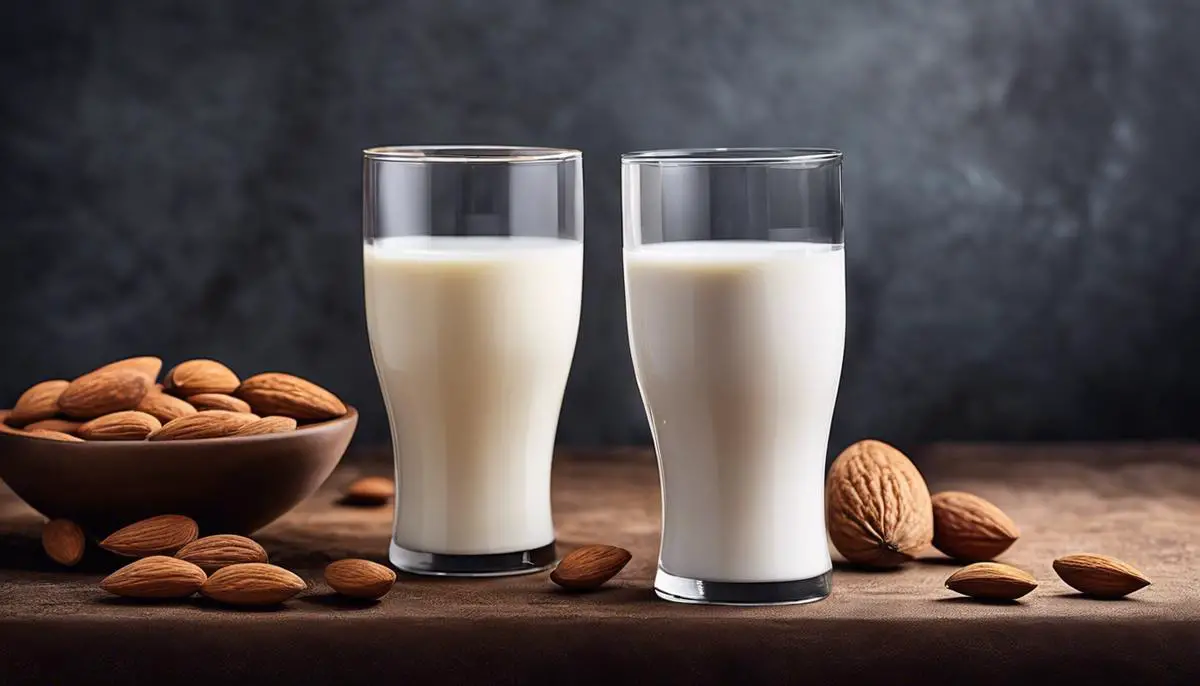
Culinary Uses and Flavor Profile
Almond Milk Magic: A Delectable Secret in the Modern Kitchen
Whispers of almond milk have been swirling through the health-conscious crowds and glossy pages of foodie magazines alike. The term ‘plant-based’ isn’t just a buzzword; it has become an anthem for the modern foodie, which relishes the fusion of health with haute cuisine.
Now, let’s get down and smooth as almond milk itself as we unfurl the tantalizing truth: Can this chic drink truly stand in for traditional milk in the culinary arts without sacrificing flavor or consistency?
Picture the scene: quaint brunches with mosaic-tiled avocado toasts, sumptuous baked goods that tempt the senses, and frothy lattes that awaken the soul. There’s a secret to keeping these experiences both indulgent and inclusive, and that secret is the versatility of almond milk. Because here’s the thing: flavor and texture are paramount in creating dishes that satisfy that inner connoisseur, and almond milk understands the assignment.
Crafting the perfect dish is akin to brewing a potion. It hinges on the seamless blending of ingredients, and guess what? Almond milk is your virtuoso performer in the world of liquid ingredients.
The naturally mild and slightly nutty flavor of almond milk complements instead of overpowering, making it an exemplary companion for sweet and savory dishes. Are you worried about that luscious, creamy texture? Smooth, unsweetened almond milk flows into soups, sauces, and custards like a dream. Voilà! No graininess, no odd aftertaste—only pure, silken elegance.
In baking, precision is the game. Each ingredient must rise to the occasion, quite literally in the case of cakes and pastries. Fear not, for almond milk steps up with grace. When recipes call for milk, substituting it with an equal amount of almond milk is akin to a magical incantation—your baked goods emerge just as moist and tender.
Perhaps it’s the petite soirée quiche or that indulgent blueberry muffin; they all bask in the glory of almond milk without a hint of compromise in taste or structure.
Let’s raise our glasses—be it a cocktail shaker or smoothie blender—to the mixer of the moment. Almond milk whirls into beverages with a downright enviable ease. Lattes? Check. Decadent hot chocolate? Absolutely. And for fitness devotees, almond milk’s rendezvous with protein powders is nothing short of a power couple’s dynamic entrance at any elite gymnasium soirée.
Every choice paints a stroke on the canvas in the grand tapestry of cooking and dining. Almond milk’s ability to slip into the role of traditional milk is its magnum opus, tailored for those who craft their lives with intention.
Far from just mimicking, almond milk brings its character to the table, welcoming those who choose to wear their dietary needs and preferences not just as a necessity but as a badge of sophisticated taste.
So, relish that there’s no need to whisper about almond milk’s potential behind velvet curtains any longer—it is a revelation, a modern elixir in the sanctuary of the kitchen. Here’s to toasting a glass swirled with the future, brimming with possibility, and not to mention delectably divine.
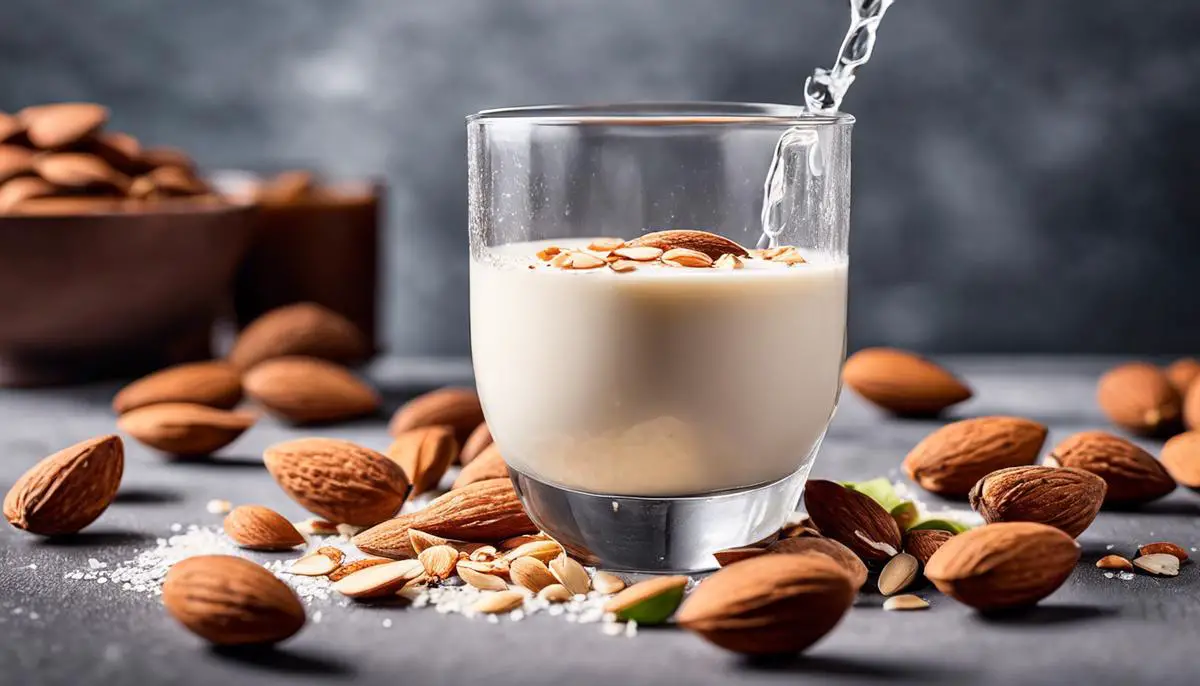
Lifestyle and Dietary Considerations
Dive into the Culinary Elegance of Almond Milk
Step into an elevated world of taste and sophistication—where almond milk is more than just a drink; it’s a culinary artist’s dream medium. This dairy-free darling has ventured far beyond the realm of breakfast cereals to grace every imaginable dish with its presence.
Versatile in its essence, almond milk offers an irresistible creamy texture that offers a sumptuous base for an array of sweet and savory creations.
For the sweet-toothed connoisseur, think decadent desserts and baked goods that benefit from the subtle nutty undertones of almond milk. Whether drizzling it into a velvety chocolate ganache or infusing it in silky custards, this milk substitute elevates simple desserts to a new level of finesse.
Not to mention the tender crumb it imparts to cakes and the delicate moistness within your favorite batch of muffins. Each bite is a testament to the transformative magic of incorporating almond milk into baking.
But why limit your experience to just desserts? The rich, smooth texture that characterizes almond milk makes it magnificently into savory soups and creamy sauces. Imagine the luxurious consistency it brings to your traditional broccoli soup or the richness it introduces to a vegan Alfredo sauce. Each spoonful is a celebration of flavors that dance harmoniously together.
Within the world of beverages, almond milk stands as a clear favorite. For the lover of the frothy latte or the creamy cup of hot chocolate, almond milk froths with dream-like ease. When blended with this plant-based milk, smoothies take on a new lightness—both in calories and flavor.
Moreover, almond milk has become the go-to companion for any culinary journey due to its extraordinary ability to seamlessly stand in for traditional milk. Whether whipping up a béchamel or tenderizing a pan of scalloped potatoes, almond milk integrates without a fuss or a clash, making it a steadfast ally in modern cooking.
Let’s not forget its role as a beacon for those with dietary needs and preferences. It has become an indispensable choice for vegans, those who are lactose intolerant, and anyone looking to reduce dairy intake without sacrificing taste or culinary possibilities. This isn’t a substitute; it’s an enhancement, a way to cater to the body’s needs without compromising flavor or enjoyment.
In the bustling kitchens of today, where innovation meets tradition, almond milk has manifested as a modern elixir—an unexpected hero ready to transform the ordinary into the extraordinary. It caters to the palate and the aesthetic and healthful lifestyle many strive to uphold.
Almond milk is not just an alternative; it’s a revelation—it’s the stylish, flavorful answer to the culinary calls of today’s gourmets and gourmands. It’s time to embrace this delightful ingredient and allow it to whisk every discerning food lover into a new era of culinary delight.
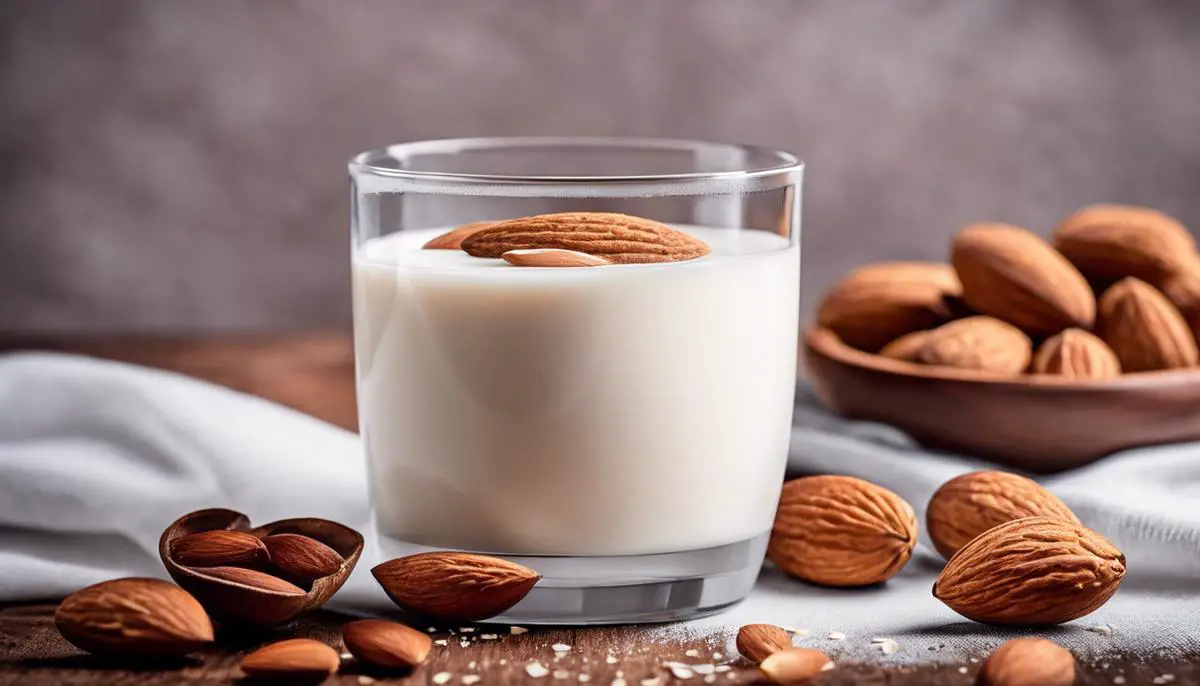
Preparation and Storage Tips
Navigating the Shelf Life of Almond Milk: A Guide to Freshness and Flavor Preservation
The age of enlightened eating and drinking is upon us, and almond milk is coasting on the wave of this new era. But with any element gracing our lifestyle choice palette, knowing how to handle and store it is vital.
After all, a well-preserved product is the secret ingredient to maintaining flavor integrity and health benefits.
When it comes to almond milk, its life outside the fridge is short-lived. Once you’ve broken the seal, consider the countdown to sipping on your trendy almond-laced latte officially ticking. Refrigeration is non-negotiable; this nutty nectar thrives in coolness, staying fresh for 7-10 days post-opening.
Unopened, things are a little different. Shelf-stable almond milk can be stored at room temperature until it arrives for its grand debut. However, don’t let this attribute tempt you to stash it away for ages; heed the expiration date religiously to prevent any compromise to its characteristic creamy goodness.
We’re all about presentation; almond milk’s packaging isn’t just about looking chic in your fridge. The carton has a purpose, shielding the liquid gold from light and air, the arch-nemeses of freshness. This safeguard slows down oxidation and keeps the delicate flavors of the almonds in check.
Freezing is a debatable realm. While technically possible, freezing can alter the smooth composition of almond milk, causing separation and graininess, which might not be ideal for those impeccable smoothies or Insta-worthy bowls. If you must freeze, reserve usage for cooking where texture shifts are more forgiving.
Pour with intention. Leaving almond milk out at room temperature for extended periods diminishes its lifespan and invites bacteria to a party we didn’t RSVP to. Always pour the quantity you’ll consume and return the carton to the chill sanctuary of your refrigerator without delay.
In short, storing almond milk is no arduous chore—it belongs in the fridge, away from the light, and must be consumed within a sensible timeframe. Stay vigilant; freshness aficionados and almond milk will continue being that versatile ally in your pursuit of culinary finesse and a nutritionally conscious lifestyle.
Keep it cool, seal it, and indulge in the almond-infused life you’ve artfully crafted.
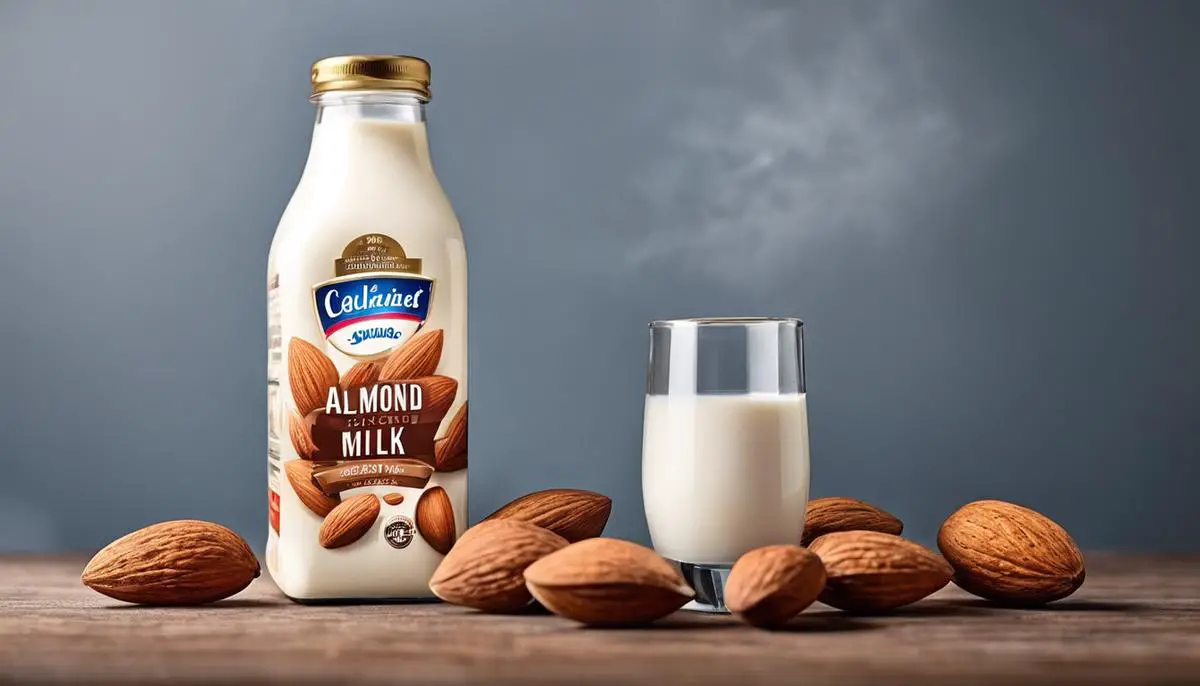
Gone are the days when milk meant just one thing. The aisles of today’s supermarkets reflect a world of diversity and choice, and almond milk has earned its place as a staple in many homes.
From its humble nutritive profile to its culinary adaptability and lifestyle versatility, almond milk is more than just a fad—it reflects our evolving dietary landscapes.
Armed with our insights on this non-dairy alternative, we trust you will find confidence in your decisions, creativity in your cooking, and satisfaction in the sustenance you choose. Embrace the almond wave, and may your palate and principles find harmony in every pour.
At Reluctant Low Carb Life, we are staunch advocates of the Health Trifecta: Fullness, Fitness, and Freshness. Additionally, we embrace the pillars of health, wellness, and graceful aging. Our mission is to provide honest and precise information to individuals dedicated to adopting a healthy lifestyle while enhancing their fitness and well-being.
We have a free monthly newsletter that is filled with information and helps you remain updated. Subscribe to the Reluctant Low Carb Life newsletter by clicking here.
Listen to our weekly podcast, Reluctant Low Carb Life, on all the major podcast platforms by clicking here.
Follow us on Instagram and Facebook by clicking the links.
Related Question
Is Almond Milk Considered A Dairy Product?
Almond milk is not considered a dairy product as it is technically a plant-based milk substitute. A dairy product is a product that comes from an animal, such as a dairy cow or even a goat. We recommend substituting unsweetened almond milk for dairy milk on a keto and low-carb diet.
You can read more about Is Almond Milk Considered A Dairy Product? by clicking here.
Do We Get Fat In Drinking Almond Milk?
Unsweetened almond milk should not make you fat. It is not only low in calories but also has no carbohydrates or low sugars. When compared to whole milk, unsweetened almond milk is a much better type of milk to drink. The sweetened version of almond milk is higher in calories, high in carbohydrates, and high in sugars.
You can read more about Do We Get Fat In Drinking Almond Milk? by clicking here.
Can I Use Real Milk To Substitute Almond Milk?
Real dairy milk and unsweetened almond milk can be interchangeable in most recipes, especially recipes for baked goods. The almond milk you are using may have more water than your natural dairy milk, so you may need to account for that in your baking time because the water may evaporate sooner, or the baking might be slower.
You can read more about Can I Use Real Milk To Substitute Almond Milk? by clicking here.
